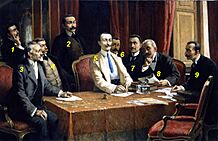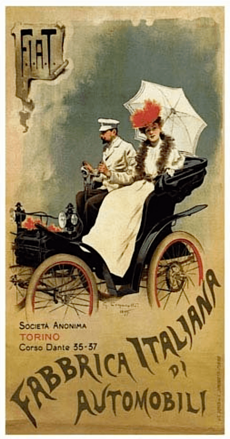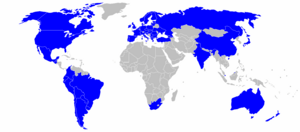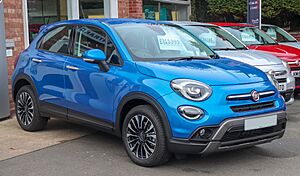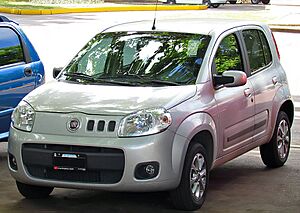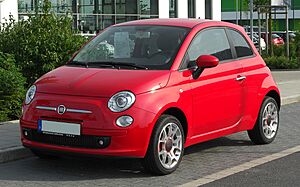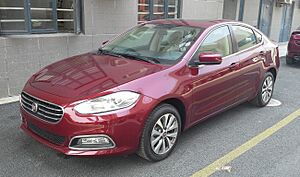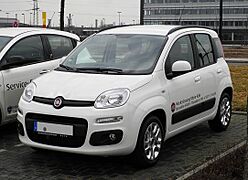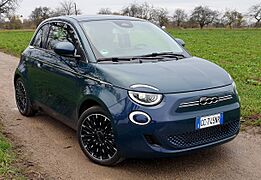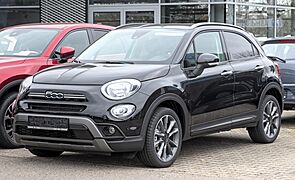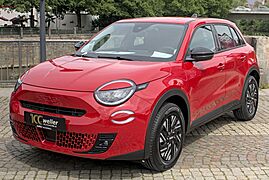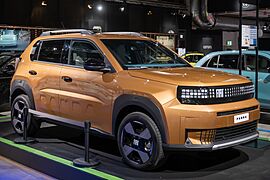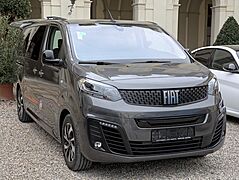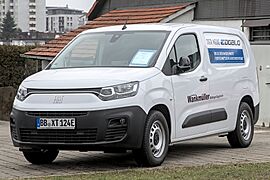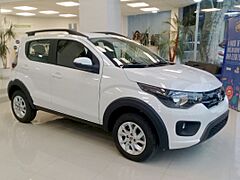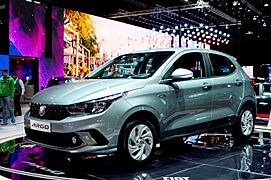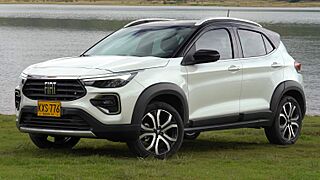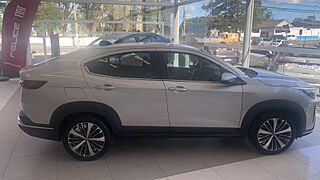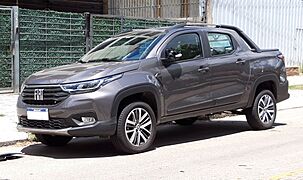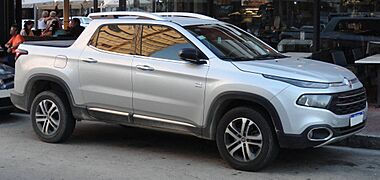Fiat facts for kids

Coloured logo
|
|
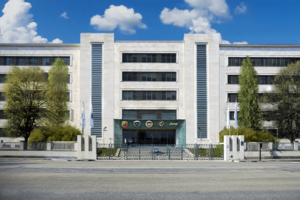
Mirafiori, headquarters and industrial district of Fiat in Turin, pictured in 2020
|
|
| Subsidiary | |
| Industry | Automotive |
| Predecessor |
|
| Founded | 1899 |
| Founder | Giovanni Agnelli |
| Headquarters |
Lingotto, Turin
,
Italy
|
|
Area served
|
Worldwide |
|
Key people
|
John Elkann (acting president) Olivier François (CEO) |
| Products | Automobiles, electric vehicles |
|
Production output
|
1,350,000 units (2023) |
| Parent | Stellantis Europe |
| Subsidiaries |
|
Fiat Automobiles S.p.A., usually called Fiat, is an Italian car maker. It started in 1899. Fiat is famous for making cars that are fun to drive and good for city life.
Fiat became part of Fiat Chrysler Automobiles in 2014. Then, in 2021, it joined Stellantis, a big group of car brands. Fiat is Italy's largest car manufacturer. For many years, it was also the biggest in Europe. It was the third largest in the world for over 20 years.
Fiat has made many different things over the years. This includes railway engines, military vehicles, farm tractors, and even aircraft.
Fiat cars are built in many places around the world. Brazil is one of the biggest production countries outside Italy. Fiat has also won many awards for its cars. It has won the "European Car of the Year" award nine times. This is more than any other car maker. Fiat cars are also known for having low CO2 emissions.
Contents
History of Fiat
Fiat was founded on July 11, 1899. Giovanni Agnelli was one of the people who started the company. The name FIAT stands for Fabbrica Italiana Automobili Torino. This means "Italian Automobiles Factory of Turin."
The first Fiat factory opened in 1900. It had 35 workers and made 24 cars. By 1903, Fiat was making a profit. It produced 135 cars that year. By 1906, this number grew to 1,149 cars. The company then started selling shares to the public.
Agnelli led the company for a long time, until 1945. Fiat's first car was the 3 ½ CV. Only 24 of these cars were built. In 1903, Fiat made its first truck. By 1908, Fiat cars were being exported to the United States. Fiat taxis also became popular in Europe around this time.
By 1910, Fiat was the biggest car company in Italy. During World War I, Fiat helped the Allies. It made aircraft, engines, machine guns, trucks, and ambulances. After the war, Fiat introduced its first tractor, the 702. By the early 1920s, Fiat made 80% of the cars in Italy.
In 1922, Fiat started building the famous Lingotto car factory. It was the largest in Europe at the time. This factory opened in 1923. It was the first Fiat factory to use assembly lines. By 1925, Fiat controlled 87% of the Italian car market.
During World War II, Fiat made military vehicles and machinery. This included fighter aircraft and light tanks. After the war, the Agnelli family returned to lead Fiat. Giovanni's grandson, Gianni Agnelli, became chairman in 1966.
In 1970, Fiat had over 100,000 employees in Italy. Its production reached 1.4 million cars that year. By 2002, Fiat built over 1 million vehicles in Italy.
On January 29, 2014, Fiat S.p.A. merged into a new company. This new company was called Fiat Chrysler Automobiles NV (FCA). This merger became official on October 12, 2014. In 2019, FCA merged with the French company PSA Group. The new big car group was named Stellantis in 2020.
Fiat Around the World
Europe
Europe is Fiat's main market, especially Italy. Fiat is very good at making small city cars and superminis. Most of its sales are in these types of cars. Fiat does not currently make very large family cars. Other brands like Lancia, Alfa Romeo, and Maserati cover those car types.
Fiat's share of the European market has changed over time. In 2000, it was 9.4 percent. By March 2009, it grew to 9.1 percent.
Fiat built its five-story Lingotto plant between 1915 and 1918. It was Europe's largest car factory back then. Later, the Mirafiori plant was also built in Turin.
Fiat's current car models include:
- City cars: Fiat 500, Fiat Panda
- Compact car: Fiat Tipo
- Mini MPV: Fiat 500L
- Mini SUV: Fiat 500X
- Roadster: Fiat 124 Spider
Fiat also sells light commercial vehicles in Europe. These are sold under the brand Fiat Professional.
Fiat cars have been sold in the UK since before World War II. The Fiat Uno was a very popular model in the UK in the 1980s. More recently, the modern Fiat 500 has been a big seller there.
South America
Fiat has invested a lot in South America. It is especially strong in Brazil, where Fiat has been the market leader for many years. Fiat built its first car plant in Brazil in 1973.
The cars sold in Brazil are similar to those in Europe. However, Brazil also has special models. These include the Palio, Siena, Palio Weekend, and Strada.
New models developed in Brazil include the Pulse, Fiorino, Toro, Argo, and Mobi. Some European models are also imported to Brazil.
North America
Fiat first came to the United States in 1908. It had a factory in Poughkeepsie, N.Y.. These early Fiats were luxury cars. The factory closed during World War I.
Fiat returned to North America in the 1950s. It sold models like the original 500 and the Fiat 124 Sport Spider. Fiat left the US car market in 1983.
In 2009, the Fiat Group bought a part of the US car maker Chrysler LLC. This brought the Fiat brand back to North America after 25 years. The first Fiat car to return was the popular Fiat 500 city car. This car is built in Mexico. Fiat also sells its commercial vehicles in North America.
Fiat stopped making the Fiat 500 in 2019. Sales of other models like the 124 Spider and 500L also ended in 2020. Fiat has announced a new electric car, the 500e, which launched in 2024.
Africa
Fiat cars began to be put together in South Africa in 1950. Full production started in 1966. Fiat also assembled cars in Egypt.
In 2022, Fiat and the Algerian government signed an agreement. This agreement aims to produce Fiat vehicles in Algeria.
Asia
Fiat's presence in China is smaller compared to other car brands. In 2012, Fiat and GAC opened a joint factory. They produced the Fiat Viaggio, a car made just for the Chinese market.
Fiat currently offers the 500 and Panda models to customers in Japan. Fiat was also present in the Indian market from 1948 until 2019.
Current production
EMEA (Europe, Middle East, Africa)
- A-segment - Fiat 500
- A-segment - Fiat New 500
- A-segment - Fiat Panda
- C-segment - Fiat Tipo
- B-segment - Fiat 600
- B-segment - Fiat Grande Panda
- Minivan - Fiat Ulysse
- Minivan - Fiat E-Doblò
LATAM (Latin America)
- Fiat Mobi
- Fiat Argo
- Fiat Cronos
- Fiat Pulse
- Fiat Fastback
- Fiat Strada
- Fiat Toro
- Fiat Fiorino
- Fiat Ducato
European Car of the Year Awards
The European Car of the Year award has been given to the Fiat Group twelve times. This is more than any other car maker. Nine of these awards were won by Fiat Automobiles models.
Fiat models that won the award:
- 1967: Fiat 124
- 1970: Fiat 128
- 1972: Fiat 127
- 1984: Fiat Uno
- 1989: Fiat Tipo
- 1995: Fiat Punto
- 1996: Fiat Bravo
- 2004: Fiat Panda
- 2008: Fiat 500
CO2 Emissions
Fiat Automobiles has been recognized for having low average CO2 emissions. In 2008, its vehicles had an average of 133.7 grams per kilometer. This shows Fiat's effort to make cars that are better for the environment.
Electric Vehicles
Fiat started working on electric vehicles in the 1970s. In 2008, Fiat showed off its Phylla concept car. It also showed the Fiat Bugster concept in Brazil.
Fiat worked with energy companies to develop new electric vehicles for Brazil. This led to the production of the Palio Weekend Electric in 2009.
In 2013, Fiat launched the electric 500e in California. Fiat's CEO, Sergio Marchionne, once said that if electric cars could be profitable, he would copy the idea. He would then add Italian design and bring it to market quickly.
Concept Cars
- 1952 Fiat Abarth 1500 Biposto
- 1954 Fiat Turbina
- 1956 Fiat 600 Multipla Eden Roc
- 1957 Fiat 1200 Stanguellini Spider
- 1961 Fiat 600 Model Y Berlinetta
- 1964 Fiat 2300 S Coupe Speciale
- 1967 Fiat 125 Executive Concept
- 1967 Fiat 125 GTZ
- 1967 Fiat Dino Parigi
- 1968 Fiat Abarth 2000
- 1969 Fiat 128 Coupe
- 1969 Fiat 128 Teenager
- 1972 Fiat 128 Pulsar Michelotti
- 1972 Fiat ESV 1500
- 1972 Fiat X1/23
- 1974 Fiat 127 Village
- 1975 Fiat Abarth 131
- 1976 Fiat 126 Cavaletta
- 1980 Fiat Panda 4×4 Strip (153)
- 1992 Fiat Grigua (170)
- 1992 Fiat Cinquecento Cita (170)
- 1993 Fiat Downtown
- 1993 Fiat Lucciola Concept (170)
- 1993 Fiat ZIC
- 1994 Fiat Punto Racer (176)
- 1994 Fiat Firepoint
- 1996 Fiat Bravo Enduro Concept (182)
- 1996 Fiat Formula 4
- 1996 Fiat Vuscia Concept
- 1996 Fiat Barchetta Coupe Concept by Maggiora
- 2004 Fiat Trepiùno
- 2005 Fiat Oltre
- 2006 Fiat FCC
- 2006 Fiat Suagna Bertone
- 2007 Fiat Barchetta Bertone
- 2008 Fiat Phylla
- 2010 Fiat FCC 3 Mio
- 2012 Fiat FCC 2
- 2014 Fiat FCC 4
Motorsport and Racing
In 1971, the Fiat 124 Sport Spider was used in the World Rally Championship. It had some success, winning races in 1972, 1973, and 1974.
The Fiat 131 Abarth was a very successful rally car. It won 18 World Rally Championship events between 1976 and 1981. It also helped Fiat win the WRC Constructors Championship three times.
After a break, Fiat returned to rallying in 2003. A Fiat Punto S1600 won the Italian Rally Championship. In 2006, the Fiat Grande Punto S2000 won the FIA European Rally Championship. It won three more times in 2009, 2010, and 2011.
Fiat's Logo and Marketing
Fiat Logo History
The FIAT initials were first used in a special logo in 1901. In 1931, the company started using a simple red shield. In 1968, a "rhomboid" logo was introduced. It had the FIAT letters on four connected diamond shapes.
In 1999, a wreath-style logo was brought back. This was to celebrate the company's 100th anniversary.
Motor Village Stores
Fiat opened its "Motor Village" stores in 2006. These are big showrooms where people can see many Fiat cars. The first one was in Turin, Italy. Later, stores opened in London and Paris.
BSM-Fiat Partnership
In 2009, the BSM (British School of Motoring) partnered with Fiat UK. BSM is a driving school. They started using the new Fiat 500 as their learner car. Fiat UK was expected to provide 14,000 cars to BSM over four years.
See also
 In Spanish: Fiat para niños
In Spanish: Fiat para niños
- CMD – Costruzioni Motori Diesel S.p.A.


